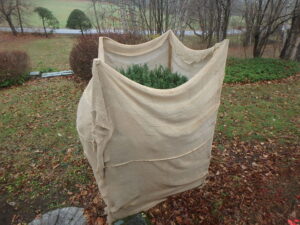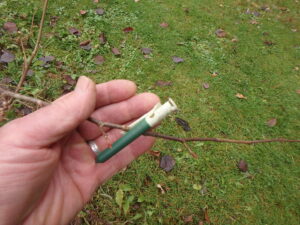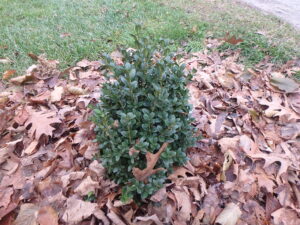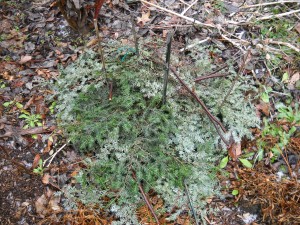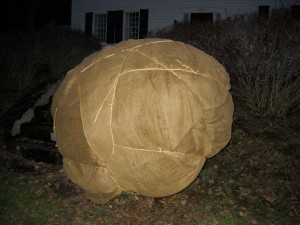Dealing with Deer
Recently I helped set up barriers around a pair of large yew shrubs. The shrubs are about 6 feet tall and wide, and in past they have been stripped bare by deer. I got four 8-foot hardwood stakes and drove them into the ground around each shrub– I needed a stepladder and a 3-lb sledge to do it.
What else? There are numerous repellents that work to a greater or lesser degree. I’ve had great luck using little garlic clips that I get from Gardener’s Supply Company. Each has a clothespin type clip to attach it to a shrub, and has little cylinder filled with garlic oil. When you poke the device with a tool they provide, it releases the odors for up to 6 months. I use 2 per shrub, or more for bigger things or more attractive deer food.
Seldom eaten shrubs include boxwood, dogwoods, forsythia, and spirea. Occasionally eaten shrubs include blueberry, hydrangeas, lilacs, summersweet clethra, and viburnums.
Protecting Plants for Winter
I know people who take down their Christmas trees right after Christmas. I am not one of them. I think of my tree as a holiday tree, or even a winter tree. I like to keep it up at least until Ground Hog’s Day, and once, when I had a really fresh one, I kept it up until St Patrick’s Day. I like trees outdoors, but having lights and green branches indoors helps dispel the gloom of winter.
Because I keep my tree up longer than most, I keep my eyes peeled for trees set by the side of the road – discarded or unsold. I consider the branches of evergreens to be gold, and bring home unwanted trees. Why? I use the branches to protect delicate plants. You can, too, so don’t throw yours out when it comes down.
Snow is a great insulator, and in recent years we‘ve had lots of snow most of the winter, starting in early December or even earlier. Not this year. It’s been warm and we’ve mostly had rain, not snow through November and December. Or we’ve had cold or snowy periods followed by warm days – a recipe for trouble. Plants do best if their roots don’t go though freeze-thaw cycles, especially plants in their first winter when the roots have not yet extended far and wide.
Freezing and thawing of soil can push plants up out of the soil, or crack the frozen soil open, exposing roots to air – which is generally lethal. Which brings me back to those Christmas trees: I cut off branches and use them as mulch around or over new or tender plants.
This year I planted 3 Himalayan blue poppy plants (Mecanopsis betonicifolia) to replace a clump that died in the winter of 2010-11. My ground is frozen now, and I want it to stay frozen, so I cut some evergreen boughs and placed them over those poppies. A 6-8 inch layer of evergreen branches will do much to keep the soil frozen if we have a few warm days. Of course a week of warm rain will penetrate even that, but there is only so much a gardening guy can do.
I have used Christmas tree boughs to protect tender shrubs by covering their branches, too. I lean the branches up against a tender rose, for example, creating a teepee that protects the above ground portion of the plant as well as its roots. Strong cold winds can kill flower buds – or entire branches of plants that really would rather be growing in Virginia, for example. I have occasionally piled straw or mulch hay over the branches for added protection.
Deer are not a problem for me: Daphne, my able-bodied, full throated corgi of great intelligence, is able to scare them away, even at night. I’m not sure how she does it, since she sleeps in her padded basket near the stove at night, not out protecting my shrubs. But deer rarely come – only passing to pick up fallen apples from time to time. (And once on Christmas Eve, before Daphne, they ate all my Brussels sprouts – though some think that damage might have been done by reindeer).
Deer repellents don’t work for long, and tall fencing for deer (8-feet is generally recommended to keep them out) is expensive. So what to do? Small shrubs like the yews favored as a front-of-the-house muffin-like decorations are easily wrapped in burlap, which will thwart even the most determined deer. Garden centers sell burlap by the yard, or in rolls. Wrap your shrub, and then keep it in place with some garden twine. This will also protect tender shrubs from winter winds.
Burlap is also good for protecting sections of the lawn. If your snowplow driver pushes sand and gravel up with the snow in a big pile at the end of the driveway, on your lawn, you will have lots of spring cleanup. If you lay down burlap (or black landscape fabric), you can catch all that messy detritus, making spring cleanup easier.
Don’t spread out a 20-foot section of material, however, as that would be impossible to move, come spring. Cut 6-foot sections and overlap them a little. If your ground is not frozen when you do this, I recommend pinning down the fabric with landscape staples.
One last idea for protecting plants in winter: you can spray your rhododendrons and azaleas with Wilt Pruf . It puts a clear waxy coating on the leaves to keep them from losing moisture and drying out once the ground has frozen and the plants cannot replace moisture lost on warm, sunny days. I’ve used this, and it does make a difference. According to their web site (www.wiltpruf.com) , the product is suitable for use by organic gardeners.
Basically I believe that plants should be able to survive on their own – without any special help from me. But I don’t always follow that rule, and protect plants, particularly young ones, from our cold winters.
Henry Homeyer is the author of 4 gardening books. His Web site is www.Gardening-Guy.com.



